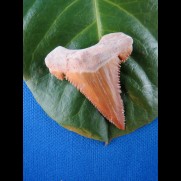-
Warenkorb ist noch leer.
MENÜ

 Haie besitzen ein Skelett aus Knorpel statt Knochen, was ihnen enorme Flexibilität verleiht. Ihre Haut ist mit winzigen, zahnähnlichen Schuppen bedeckt, die den Wasserwiderstand reduzieren. Besonders bemerkenswert sind die hochentwickelten Sinnesorgane der Haie:
Haie besitzen ein Skelett aus Knorpel statt Knochen, was ihnen enorme Flexibilität verleiht. Ihre Haut ist mit winzigen, zahnähnlichen Schuppen bedeckt, die den Wasserwiderstand reduzieren. Besonders bemerkenswert sind die hochentwickelten Sinnesorgane der Haie:2,0 cm facettenreich gefärbter Zahn des Tigerhai Der 2,0 cm große Zahn des Tigerhai (Galeocerdo cuvi..
29,00€ Netto 24,37€
2,0 cm großer Zahn des Tigerhai aus Peru Der 2,0 cm große Zahn des Tigerhai (Galeocerdo cuvier) aus ..
18,00€ Netto 15,13€
2,3 cm brauner Zahn des Tigerhai Der 2,3 cm große fossile Zahn des Tigerhai (Galeocerdo cuvier) besi..
25,00€ Netto 21,01€
2,3 cm großer heller Zahn des Galeocerdo eaglesomei Der 2,3 cmg große Zahn des Galeocerdo eaglesome..
23,00€ Netto 19,33€
2,4 cm grauer Zahn des Tigerhai Der 2,4 cm große fossile Zahn des Tigerhai (Galeocerdo cuvier) besit..
25,00€ Netto 21,01€
2,4 cm heller schön erhaltener Zahn des Galeocerdo eaglesomei Der 2,4 cmg große Zahn des Galeocerdo..
23,00€ Netto 19,33€
2,4 cm Notorynchus primigenius (Grauhai †) - Haizahn aus Eckelsheim #1 Der 2,4 cm lange Zahn des N..
67,00€ Netto 56,30€
2,4 cm scharfer Zahn des Tigerhai Der 2,4 cm fossile Zahn des Tigerhai (Galeocerdo cuvier) besitzt e..
22,00€ Netto 18,49€
2,4 cm schön gefärbter Zahn des Tigerhai Der 2,4 cm große fossile Zahn des Tigerhai (Galeocerdo cuvi..
26,00€ Netto 21,85€
2,5 cm großer Zahn des Tigerhai Der 2,5 cm große fossile Zahn des Tigerhai (Galeocerdo cuvier) besit..
22,00€ Netto 18,49€
2,5 cm Notorynchus primigenius (Grauhai †) - Haizahn aus Eckelsheim #5 Der 2,5 cm lange Zahn des N..
65,00€ Netto 54,62€
2,5 cm Notorynchus primigenius (Grauhai †) - Haizahn aus Eckelsheim #7 Der 2,5 cm lange Zahn des N..
55,00€ Netto 46,22€
2,5 cm Zahn des Tigerhai mit breiter Wurzel Der 2,5 cm große fossile Zahn des Tigerhai (Galeocerdo c..
27,00€ Netto 22,69€
2,6 cm dunkler Zahn des Tigerhai Der 2,6 cm große fossile Zahn des Tigerhai (Galeocerdo cuvier) ist ..
22,00€ Netto 18,49€
2,6 cm grau-brauner Zahn des Tigerhai Der 2,6 cm große Zahn des Tigerhai (Galeocerdo cuvier) besitzt..
22,00€ Netto 18,49€
2,6 cm schwarzbrauner Zahn des Tigerhai Der 2,6 cm große fossile Zahn des Tigerhai (Galeocerdo cuvie..
25,00€ Netto 21,01€
2,7 cm graublauer Zahn des Tigerhai Der 2,7 cm große fossile Zahn des Tigerhai (Galeocerdo cuvier) b..
22,00€ Netto 18,49€
2,7 cm Notorynchus primigenius (Grauhai †) - Haizahn aus Eckelsheim #2 Der 2,7 cm lange Zahn des N..
65,00€ Netto 54,62€
2,7 cm Notorynchus primigenius (Grauhai †) - Haizahn aus Eckelsheim #4 Der 2,7 cm lange Zahn des N..
65,00€ Netto 54,62€
2,7 cm Zahn des Tigerhai mit blauem Zahnschmelz Der 2,7 cm große fossile Zahn des Tigerhai (Galeocer..
22,00€ Netto 18,49€